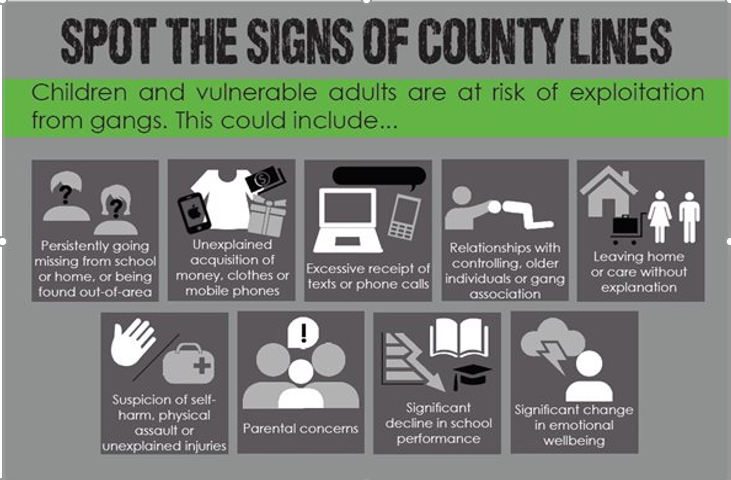Keeping Safe in the Community
Child Criminal Exploitation, Gangs and County Lines
The national definition of child sexual exploitation (CSE) and child criminal exploitation (CCE) states:
‘Both CSE and CCE are forms of abuse and both occur where an individual or group takes advantage of an imbalance in power to coerce, manipulate or deceive a child into sexual or criminal activity. Whilst age may be the most obvious, this power imbalance can also be due to a range of other factors including gender, sexual identity, cognitive ability, physical strength, status, and access to economic or other resources. In some cases, the abuse will be in exchange for something the victim needs or wants and/or will be to the financial benefit or other advantage (such as increased status) of the perpetrator or facilitator. The abuse can be perpetrated by individuals or groups, males or females, and children or adults. The abuse can be a one-off occurrence or a series of incidents over time, and range from opportunistic to complex organised abuse. It can involve force and/or enticement based methods of compliance and may, or may not, be accompanied by violence or threats of violence. Victims can be exploited even when activity appears consensual and it should be noted exploitation as well as being physical can be facilitated and/or take place online.’
County Lines (Child Criminal Exploitation), is a form of criminal exploitation where highly organised criminal networks coerce or force children and young people into storing drugs or money and/or transporting them to other areas. The county lines gangs use sophisticated methods to groom young people into criminal activity and often trick them into a debt bondage which they then have to pay off. It is not uncommon for threats of violence against the young person and/or their family to be made of they do not comply. The illustration below outlines some of the signs that a child or young person might be at risk of exploitation:


The following websites might also be useful:
Child Sexual Exploitation
The national definition of child sexual exploitation (CSE) and child criminal exploitation (CCE) states:
‘Both CSE and CCE are forms of abuse and both occur where an individual or group takes advantage of an imbalance in power to coerce, manipulate or deceive a child into sexual or criminal activity. Whilst age may be the most obvious, this power imbalance can also be due to a range of other factors including gender, sexual identity, cognitive ability, physical strength, status, and access to economic or other resources. In some cases, the abuse will be in exchange for something the victim needs or wants and/or will be to the financial benefit or other advantage (such as increased status) of the perpetrator or facilitator. The abuse can be perpetrated by individuals or groups, males or females, and children or adults. The abuse can be a one-off occurrence or a series of incidents over time, and range from opportunistic to complex organised abuse. It can involve force and/or enticement based methods of compliance and may, or may not, be accompanied by violence or threats of violence. Victims can be exploited even when activity appears consensual and it should be noted exploitation as well as being physical can be facilitated and/or take place online.’
Children and young people are often tricked into believing they are in a loving, consensual relationship and do not realise they are being groomed by a perpetrator. By the time they realise what is happening they may be trapped into children sexual exploitation by a debt bondage and/or threats against themselves or their families. The illustration below outlines some of the signs that a child or young person may have been groomed into child sexual exploitation:
Exploitation - Spot the Signs Poster - NWG Network
The following websites might also be useful (right click on logo):
ROTHERHAM SAFEGUARDING CHILDREN PARTNERSHIP
Knife Crime and Serious Violence
Carrying a knife or weapon is illegal at any age and even if a child or young person stated they were in possession of one to protect themselves, they could still be prosecuted. In actual fact, statistics show that a person carrying a knife is much more likely to use it and be stabbed themselves. The Police are able to search anyone they suspect of being in possession of a weapon as are staff in schools.
For more information right click on the following:
ROTHERHAM SAFEGUARDING CHILDREN PARTNERSHIP
Child Trafficking and Modern Slavery
Child Trafficking is where children and young people are tricked, forced or persuaded to leave their homes and are moved or transported and then exploited, forced to work or sold. Child Traffickers might move children into the UK from outside or may move children around within the UK for purposes of:
- sexual exploitation
- benefit fraud
- forced marriage
- domestic slavery like cleaning, cooking and childcare
- forced labour in factories or agriculture
- committing crimes, like begging, theft, working on cannabis farms or moving drugs.
For more information, right click on the following link:

